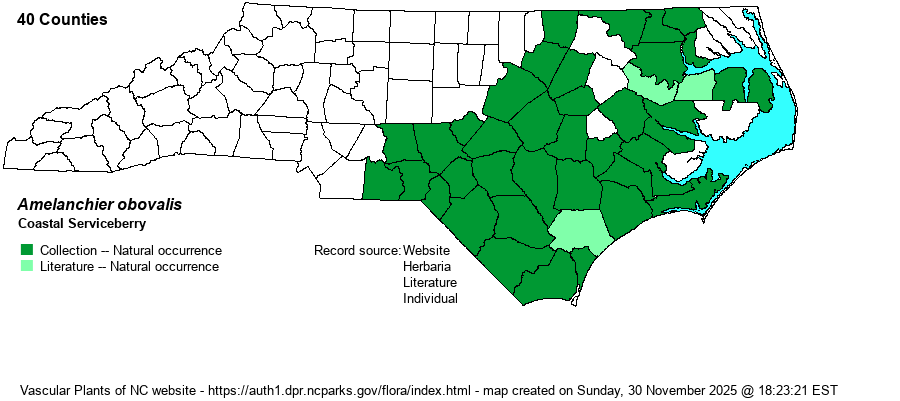| Author | (Michaux) Ashe | |
| Distribution | Occurs essentially throughout the state’s Coastal Plain; however, there are few records from the counties north of Albemarle Sound. It barely ranges into the extreme eastern edge of the Piedmont.
This is a species of the south Atlantic Coastal Plain, ranging from southern NJ only to GA, where scarce, and also rarely to northeastern AL. There are scattered records in the Piedmont of NC, SC, GA, and AL. It does not range south to FL.
| |
| Abundance | Common to locally abundant in the Sandhills region; slightly less numerous elsewhere in the Coastal Plain, but still a common species in the southern part of the province. Less numerous in the far eastern counties (such as on the Pamlimarle Peninsula). Very rare in the eastern edge of the Piedmont. | |
| Habitat | This is a characteristic shrub of acidic wetlands such as pocosins, especially streamhead pocosins. It also occurs in other acidic wetlands such as savannas or wet flatwoods margins, margins of bays or acidic ponds, etc. It is not numerous in richer wetlands such as swamps or wet bottomlands. |
| Phenology | Blooms in early spring (March-April), before leaves emerge; fruits in May and June. | |
| Identification | This is a familiar deciduous shrub to workers in the Coastal Plain, especially in pocosin habitats; it grows only to about 3-4 feet tall. It is one of only two rhizomatous Amelanchier species (along with A. spicata) in the state, and is often noticed by its habit of occurring in dense, almost circular stands of waist-high bushes along the edges of pocosins and bays, as well as in streamhead pocosins. The leaves are more oblong or evenly rounded (at both ends) than are most other serviceberries, which tend to be more ovate, or more cordate at the base; however, A. spicata is quite similar. This latter species grows mainly in drier habitats and has the summit of the ovary quite tomentose/hairy; this species favors acidic (often pocosins) wetlands and has the ovary summit nearly glabrous. | |
| Taxonomic Comments | Nearly all references consider this as a good species, but (surprisingly) BONAP has this taxon lumped in with A. canadensis. Weakley (2018) indicates that it is occasionally named as A. canadensis var. obovalis, though he has it as a full species.
| |
| Other Common Name(s) | Coastal Plain Serviceberry, Southern Juneberry, Obovate Coastal Juneberry | |
| State Rank | S4 | |
| Global Rank | G4G5 | |
| State Status | | |
| US Status | | |
| USACE-agcp | | |
| USACE-emp | | |

